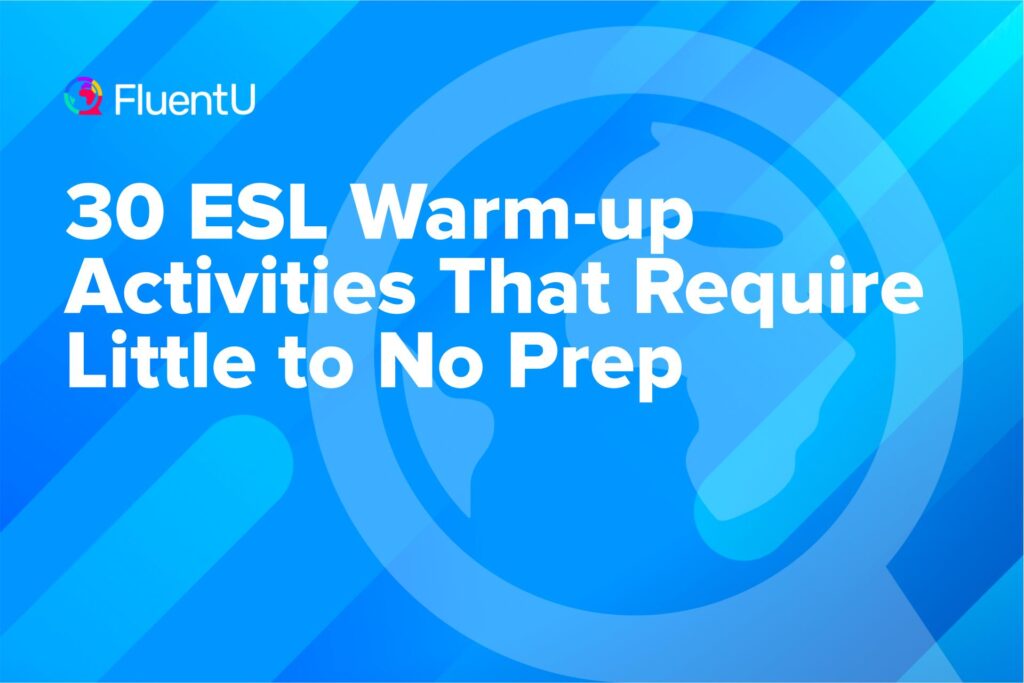Contents
- 1. Stretch
- 2. Have a dance party
- 3. Pass the ball
- 4. “Simon Says”
- 5. Tongue twisters
- 6. Word chain
- 7. Pictionary
- 8. Group count
- 9. Top 5 Quiz
- 10. Physical Polling
- 11. Mad libs
- 12. Map quest
- 13. “Who Am I?”
- 14. Odd one out
- 15. Two truths and a lie
- 16. Scattergories
- 17. Charades
- 18. Running dictation
- 19. Twenty questions
- 20. Story cubes
- 21. Convince me
- 22. Hot seat
- 23. Complete the sentence
- 24. Synonym swap
- 25. Describe a drawing
- 26. Peer interviews
- 27. Question of the day
- 28. “Find someone who…”
- 29. Jumbled sentences
- 30. Fast dictation
- And One More Thing...
30 ESL Warm-up Activities That Require Little to No Prep

ESL warm-up activities should awaken students’ minds, voices and bodies. They only need to take a few minutes, but they can make the difference between sleepy, uninspired students and engaged ones. I’ve gathered my favorite low- to no-prep warm-up activities into this post.
Download: This blog post is available as a convenient and portable PDF that you can take anywhere. Click here to get a copy. (Download)
1. Stretch
Best for: kids, teens
Activity type: physical
Lead a group stretch to physically warm students’ bodies up. You can use this as an opportunity to reinforce directional vocabulary as you call out each move. While this is a hit among kids, I’ve also used it to energize a sleepy group of first-period ninth graders!
2. Have a dance party
Best for: kids
Activity type: physical
Get students up and moving by playing a song with some well-known moves, like “The Hokey Pokey,” “The Locomotion” or “YMCA.” These songs are pretty old, so you might need to show the moves to kids the first time. Lead the class by dancing with them!
3. Pass the ball
Best for: kids
Activity type: physical, vocabulary, speaking
Choose a category and have students say something in the category when the ball is passed to them. This is a great way to build vocabulary and practice speaking skills, but it’s also an excellent way to help younger students practice speaking only when it’s their turn to speak.
4. “Simon Says”
Best for: kids
Activity type: physical, listening
Tell students to do silly things like touch their noses. If you preface the command with “Simon says,” then the kids need to do it. If you don’t, they shouldn’t. Students who fail should sit down until one person is left standing. This is especially great among little kids, since it’s a good way to practice listening skills and following directions. Plus, it’s fun! You can also give students a chance to give their own instructions to practice the imperative.
5. Tongue twisters
Best for: kids
Activity type: speaking
This one takes a few minutes of prep but once you have your list of tongue twisters, you can use them anytime. Compile a list of your favorite English tongue twisters.
I recommend organizing them first by the sound that they reinforce, then by their difficulty level. For example, you can start students out with the well-known “She sells seashells by the seashore” and work their way up to something more ridiculous that also works on the “s” and “sh” sounds, like “Sasha shivers silently, selling six silky seashells by the seashore, where swift, slippery sea snails slither.”
Use one tongue twister per warm-up and have students try to say them without tripping up.
6. Word chain
Best for: kids
Activity type: vocabulary, speaking
Choose a category and a starting word, then go around the room. Students need to say a word of that category that starts with the last letter of the previous word, without repeating previous words. If the category is “food,” for example, then the string of words might look like this: “Tomato – Oatmeal – Lettuce – Eggplant – Tofu,” and so on.
This is a great way to practice vocabulary and spelling. If someone is stumped, you can move backwards through the word’s spelling until they think of something.
7. Pictionary
Best for: kids
Activity type: vocabulary
Draw something and students have to guess what it is. Use something you’re studying or have fun with it. For example, for older kids you can draw out idioms literally, then discuss what the idiom means (eg. “no strings attached” or “don’t count your chickens before they hatch”).
8. Group count
Best for: kids
Activity type: listening, speaking
Choose a reasonable goal number, like 10 or 15. A student starts the count at one and the rest of the group has to work together to count up to the goal number by calling out the next number. If two people call out a number at the same time, the count resets. This is a fun way to work on numbers, counting and teamwork.
You can also use this to practice spelling, by having students work together to spell out a word.
9. Top 5 Quiz
Best for: kids
Activity type: vocabulary, writing
This is a kid-friendly variation on the classic game show, Family Feud. Give kids a category, and have them write one answer. Then, reveal what the “top five” answers are. If their answer is on the list, they get a point.
There are many YouTube videos available for this game, so the only prep you need to do is find them. Here’s a playlist of eight themed Top Five games.
10. Physical Polling
Best for: kids, teens
Activity type: physical, listening
Designate one side of the room to mean “yes,” the other to mean “no” and the middle to mean “maybe” or “not sure.” Ask a yes or no question and have students move to different parts of the room based on their answers.
You can use this as a fun way to warm up with silly questions, like “Do you have a pet?” or “Is your favorite season winter?” or ask questions that review things you’ve been studying.
11. Mad libs
Best for: kids, teens
Activity type: vocabulary
If you’re not familiar with them, Mad Libs ask players to come up with random words in categories like “noun,” “color,” “body part,” “name,” etc. These words are then plugged into blanks in a story for a comic result.
This activity takes some minimal prep. You can either buy some Mad Libs books, download the official Mad Libs apps or find fan-made Mad Libs online. Helps students remember parts of speech. You can encourage them to use the vocabulary you’ve been working on.
12. Map quest
Best for: kids, teens
Activity type: listening
This one takes some prep but it’s an excellent way to practice following directions. Give all students the same simple map. Tell them your starting point and give directions to somewhere. Students follow along, then see if everyone wound up in the same end location.
13. “Who Am I?”
Best for: kids, teens
Activity type: physical, listening, speaking
Pre-write the names of people, animals, things, etc. in large letters on pieces of paper. Choose one at random and put it on your forehead or pin it behind you on the board without looking at it. Have students take turns telling you something about your person or animal, without saying what it is. Try to guess what you picked based on their prompts.
If you have something they can wear on their heads—like headbands or hats—you can have students pair off and do the game themselves.
14. Odd one out
Best for: kids, teens
Activity type: vocabulary, reading
Give students a list of words and have them figure out which word doesn’t belong. For example, in the list: “ear, mouth, shoe, finger” the odd one out is “shoe” since it’s not a body part. You can work this around whatever vocabulary you’re currently learning.
You can also play around with this for pronunciation and spelling. For example, say these words out loud and ask which is the odd one out: “child, shampoo, shower, shoes” (the answer is “child” because it starts with “ch” and not “sh”).
15. Two truths and a lie
Best for: kids, teens
Activity type: listening, speaking
This is often used as an icebreaker since it’s a fun way to get to know others. Each student shares three statements about themselves, two true and one false. The class guesses the lie. You can pair students off to make this a more snappy activity and give everyone a chance to talk, but I recommend doing this as a full-class activity with teens who may need a bit more supervision in their topics of conversation.
16. Scattergories
Best for: kids, teens
Activity type: vocabulary, writing
Either print out or have students write a list of categories on a sheet of paper. Choose a random letter, then give students a set amount of time to come up with a word for each category that starts with that letter. You can add an element of scoring to this by reading out your own answers. For each category, students earn 0 points if they didn’t come up with a word, 1 point if they came up with the same word as you and 2 points if they came up with a different word.
If you’re not sure where to start with this one, there are plenty of online resources, or you can choose categories based on the vocab they’re studying.
17. Charades
Best for: kids, teens
Activity type: physical, vocabulary
Call one student up to the front of the class and give them a word or phrase. The student needs to act out their given word while the rest of the class guesses. The winner gets to be the next person to act out a word. This is an excellent way to teach non-verbal communication and practice vocabulary recall.
18. Running dictation
Best for: kids, teens
Activity type: physical, listening, speaking, reading
Set this up in advance by printing out several copies of the same passage and placing them at the front of the classroom. Divide students into pairs and have them stand at the back of the classroom. One student is the “Runner” and the other is the “Secretary.” The Runner runs to the front to read your prepared printout, then runs back to their partner. The Secretary transcribes the information.
Give students a time limit to make this more challenging, or modify it not to include actual running if you don’t have the space or if you’re working with older students who might not be as inclined to run.
19. Twenty questions
Best for: kids, teens
Activity type: listening, speaking
One person chooses a person, place or thing and others try to figure out what it is by asking yes or no questions. This one works best by pairing students off, but you can also lead the game and have students take turns asking questions.
20. Story cubes
Best for: kids, teens
Activity type: speaking
Students roll dice with pictures and create a story based on the images. This promotes creativity and speaking skills. You need to make these in advance, look for pre-made ones on Amazon or download an app. This encourages creativity and forming complete sentences, but it’s especially great for having students practice sequence words (first, then, finally).
21. Convince me
Best for: teens, adults
Activity type: speaking
Pair students off and give the class a topic that has two sides. One student has to argue for it while the other argues against it. Set a timer for 1-5 minutes for each side to argue their point. Topics can be anything but for the sake of a quick warm-up, I prefer to err on the side of silly. Some ideas: pineapple on pizza, cats vs. dogs, the best superpower.
22. Hot seat
Best for: teens, adults
Activity type: vocabulary, listening, speaking
This is a variation on the “Who Am I?” game. One student sits at the front with their back to the board. Write a word on the board, and the other students give clues until the student guesses the word. You can also have a group of students in the hot seats, with the first person to guess the word behind them declared as the winner.
23. Complete the sentence
Best for: teens, adults
Activity type: writing
Write the beginning of a sentence on the board (e.g., “If I could travel anywhere, I would go to…”). Set a timer and let students write a paragraph or two to complete the sentence. You can then call on some students who want to share their answers or start a class-wide discussion on the prompt topic.
24. Synonym swap
Best for: teens, adults
Activity type: vocabulary, writing
Write a sentence on the board and challenge students to replace each word with a synonym. Start with something simple to make it easy for students to come up with creative ways to rephrase it. For example, a sentence like “The child ate a red fruit” can become “The girl devoured a crimson apple.”
25. Describe a drawing
Best for: teens, adults
Activity type: listening, speaking
Pair students off and give each pair two artworks, one for each student. Students don’t share their images. Instead, they describe them while their partner draws what they describe. Then, compare the drawings to the actual picture. Do the same for the other image. Remind students that this isn’t about their artistic prowess, and that it’s okay to be loose and silly with it!
26. Peer interviews
Best for: adults
Activity type: listening, speaking
Students pair up and interview each other on a given topic, then present their partner to the class. You can combine this with role play, by giving each student their own character to act out. It’s also a great way to help students practice for job interviews.
27. Question of the day
Best for: all ages
Activity type: writing
Write a thought-provoking question on the board and give students a set time to discuss their answers in pairs or small groups. You can adapt this to any age by making the question age-appropriate. You can also reuse it as many times as you need, and even use it to set up a routine—it gives students something to do as they show up for class.
28. “Find someone who…”
Best for: all ages
Activity type: physical, listening, speaking
Give students a prompt, like “Find someone who has the same number of siblings as you,” or “Find someone who has the same favorite color as you.” Students then get up and speak to their classmates, looking for someone who matches the criteria you gave them. This is a great icebreaker, encouraging even quiet students to speak to others in the class.
29. Jumbled sentences
Best for: all ages
Activity type: reading, writing
Write a few sentences on the board, with their words out of order. Ask students to rearrange the words into the correct sentences. You can also print out pre-made worksheets.
30. Fast dictation
Best for: all ages
Activity type: listening, writing
Find a short story or paragraph about a topic you’re learning about or your students might be interested in. Read the paragraph out loud at native English speaker speed. Students have to write down as much as they can, or take notes on the main ideas. At the end of the activity, you can discuss what they managed to note down, or hand out a printout of the paragraph so they can compare their notes to the writing.
You can use the FluentU program for this—play a video without the subtitles, then turn on English subtitles and go through the video one sentence at a time.
FluentU takes authentic videos—like music videos, movie trailers, news and inspiring talks—and turns them into personalized language learning lessons.
You can try FluentU for free for 2 weeks. Check out the website or download the iOS app or Android app.
P.S. Click here to take advantage of our current sale! (Expires at the end of this month.)

When you use effective warm-ups and see how they transform your class, I’m sure that you’ll make them a regular part of your ESL lesson plans. Schedule at least five minutes at the beginning of each class to use warm-ups!
And One More Thing...
If you like learning English through movies and online media, you should also check out FluentU. FluentU lets you learn English from popular talk shows, catchy music videos and funny commercials, as you can see here:
The FluentU app and website makes it really easy to watch English videos. There are captions that are interactive. That means you can tap on any word to see an image, definition, and useful examples.
For example, when you tap on the word "searching," you see this:
Learn all the vocabulary in any video with quizzes. Swipe left or right to see more examples for the word you’re learning.

FluentU helps you learn fast with useful questions and multiple examples. Learn more.
The best part? FluentU remembers the vocabulary that you’re learning. It gives you extra practice with difficult words—and reminds you when it’s time to review what you’ve learned. You have a truly personalized experience.
Start using the FluentU website on your computer or tablet or, better yet, download the FluentU app from the iTunes or Google Play store. Click here to take advantage of our current sale! (Expires at the end of this month.)










